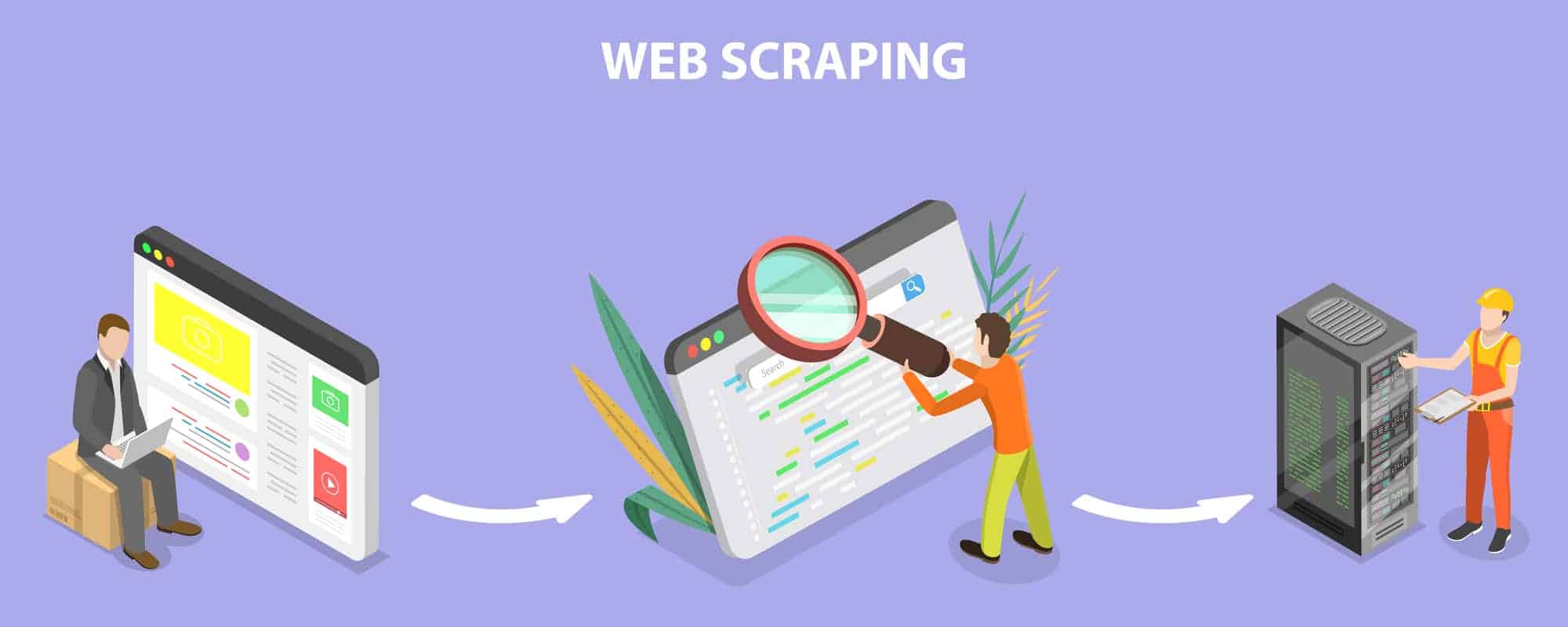Web scraping, at its core, is a powerful tool for data extraction. It involves programmatically accessing a website and extracting useful information. In today’s data-driven world, this technique is invaluable for gathering large volumes of data quickly. From market research to sentiment analysis, web scraping aids in various applications. For instance, businesses often use it to monitor competitors’ pricing strategies, while data journalists scrape websites for news aggregation.
One notable example is the use of web scraping in the travel industry. Companies like Skyscanner and Kayak aggregate flight and hotel prices from various sources, providing users with a comprehensive view of their options. This is web scraping in action, enhancing user experience and aiding decision-making.
Setting Up Your Python Environment for Scraping
To begin with web scraping in Python, setting up a proper environment is crucial. Python, known for its simplicity and rich ecosystem, is a favorite for this task. Let’s start by installing Python on your system. You can download it from the official Python website.
Step 1: Installing Python
After installing Python, you’ll need a code editor. For beginners, IDLE or Jupyter Notebook are good choices. They are user-friendly and perfect for running Python scripts.
Step 2: Setting Up a Virtual Environment
It’s a best practice to use a virtual environment for your projects. This keeps your dependencies organized and avoids version conflicts. You can create a virtual environment using the following command in your terminal:
python -m venv my_scraping_project
Step 3: Activating the Virtual Environment
On Windows, activate it using:
my_scraping_project\\Scripts\\activate
On macOS or Linux:
source my_scraping_project/bin/activate
Step 4: Installing Necessary Libraries
Web scraping with Python typically involves libraries like Requests for making HTTP requests and BeautifulSoup for parsing HTML. Install them using pip:
pip install requests beautifulsoup4
Let’s put these tools to use with a simple example. Suppose you want to scrape the latest news headlines from a website. Here’s how you can do it:
Example: Scraping News Headlines
import requests
from bs4 import BeautifulSoup
# URL of the website
url = '<https://example-news-website.com>'
# Send a GET request
response = requests.get(url)
# Parse HTML content
soup = BeautifulSoup(response.text, 'html.parser')
# Extract headlines
for headline in soup.find_all('h2'):
print(headline.text.strip())
In this code, we’re sending a GET request to a news website, parsing the returned HTML, and then extracting and printing the text of each headline tagged as h2. Every line of code here is a step towards achieving our scraping goal, showing how Python makes web scraping accessible even for beginners.
As you embark on your web scraping journey, remember to respect the website’s terms of service and privacy policies. Some websites explicitly prohibit scraping, so it’s important to be aware of legal and ethical considerations. Stay tuned for more advanced techniques and tips in the following sections of this guide.
Essential Libraries and Tools for Web Scraping

Welcome to the world of BeautifulSoup, a Python library that’s as delightful as it sounds. It’s the go-to tool for parsing HTML and XML documents, making web scraping a breeze. But why is BeautifulSoup so popular? It’s simple: it turns complex HTML into a navigable tree of Python objects. This means you can quickly select the elements you need without getting bogged down in web page intricacies.
Imagine you’re trying to extract all the headlines from a news website. With BeautifulSoup, it’s as easy as pie. Here’s a snippet to show you how:
from bs4 import BeautifulSoup
import requests
# Get HTML from a webpage
response = requests.get('<https://example-news-website.com>')
soup = BeautifulSoup(response.text, 'html.parser')
# Extract and print all headlines
for headline in soup.find_all('h1'):
print(headline.text.strip())
In this example, soup.find_all('h1') effortlessly fetches all <h1> tags (often used for main headlines). Just a few lines of code, and voilà, you have your headlines!
Utilizing Requests and Selenium for Dynamic Scraping
Now, let’s talk about fetching web pages. You might have heard of Requests, a Python library that makes HTTP requests (like accessing a web page) as easy as asking, “Can I have this, please?” It’s straightforward and elegant, perfect for static websites. Here’s a quick look at how Requests works:
import requests
# Fetch the content of a web page
response = requests.get('<https://example-static-website.com>')
print(response.text) # Prints the HTML of the webpage
But what about dynamic websites, where content changes based on user interactions? This is where Selenium enters the scene, a tool that lets you automate web browsers. It’s like having a robot that clicks, scrolls, and fills forms on web pages. Selenium is a bit more complex but incredibly powerful. Let’s see it in action:
from selenium import webdriver
# Set up the WebDriver (here, we use Chrome)
driver = webdriver.Chrome('path/to/chromedriver')
# Open a web page
driver.get('<https://example-dynamic-website.com>')
# Let's say we want to click a button
button = driver.find_element_by_id('myButton')
button.click()
# Now, we can get the updated HTML
updated_html = driver.page_source
print(updated_html)
# Don't forget to close the browser!
driver.quit()
In this snippet, we open a website, click a button, and then grab the updated HTML. It’s like magic, but for web scraping!
As you dive into the realms of BeautifulSoup, Requests, and Selenium, remember, with great power comes great responsibility. Always scrape ethically and respect the websites you visit. Now, let’s gear up for more scraping adventures in the next section of our journey.
Building Your First Web Scraper
Ready to build your first web scraper? Let’s roll up our sleeves and dive into BeautifulSoup, a tool that makes web scraping with Python feel like a walk in the park. But first, a quick stat to pique your interest: according to a study by Moz, web scraping is used by over 17% of marketers for collecting data. So, you’re in good company!
1. Fetching the Web Page
Our first step is to fetch the web page’s HTML. We’ll use the Requests library for this:
import requests
url = "<https://example.com>"
response = requests.get(url)
html_content = response.text
2. Parsing HTML with BeautifulSoup
Now that we have the HTML content, let’s parse it:
from bs4 import BeautifulSoup
soup = BeautifulSoup(html_content, 'html.parser')
3. Extracting Data
Let’s say we want to extract all paragraph texts from the page. Here’s how we do it:
paragraphs = soup.find_all('p')
for paragraph in paragraphs:
print(paragraph.text)
Voila! You’ve just scraped your first data.
Handling and Navigating HTML Elements Effectively
Navigating HTML elements is crucial for effective web scraping. Here are a few tips:
- Identify Unique Attributes: Look for unique
idorclassattributes. For example,soup.find(id="uniqueId")fetches the element with a specific ID. - Hierarchical Traversal: Understand the parent-child relationships in HTML. BeautifulSoup allows navigating these relationships easily.
Example: Navigating HTML Hierarchy
Suppose we want to find a specific element within a div:
div = soup.find('div', class_='example-class')
specific_element = div.find('span')
In this example, we first locate a div with a class ‘example-class’ and then find a span within it.
Remember, the key to successful scraping is understanding the structure of the webpage you are working with. Use the developer tools in your browser to inspect the HTML structure – it’s a lifesaver for web scrapers!
Advanced Techniques in Web Scraping

As you delve deeper into the world of web scraping, mastering regular expressions (regex) becomes a superpower. Regex is a sequence of characters used to search and manipulate strings based on specific patterns. It’s like a secret code for unlocking the full potential of text data extraction.
Here’s a fun fact to get you excited: A study by Stack Overflow suggests that over 30% of programmers use regex regularly. It’s a game-changer in text processing!
Using Regex in Python
Imagine you’re scraping a website and you need to extract all email addresses. With regex, this becomes a straightforward task. Here’s how you can do it:
import re
text = "Contact us at info@example.com or support@example.com"
emails = re.findall(r'\\b[A-Za-z0-9._%+-]+@[A-Za-z0-9.-]+\\.[A-Z|a-z]{2,}\\b', text)
for email in emails:
print(email)
This code snippet uses a regex pattern to find sequences that match the structure of an email address. The findall function scans through the given text and fetches all instances that match our pattern.
Dealing with JavaScript-Heavy Websites Using Selenium
When it comes to dynamic websites where content is loaded asynchronously via JavaScript, traditional scraping methods fall short. This is where Selenium, a tool that automates web browsers, comes into play.
Scraping a Dynamic Website with Selenium
Let’s say you want to scrape data that’s loaded dynamically on a webpage. Here’s how Selenium can help:
from selenium import webdriver
# Set up the WebDriver
driver = webdriver.Chrome('path/to/chromedriver')
# Open the web page
driver.get('<https://example-dynamic-website.com>')
# Wait for the content to load
driver.implicitly_wait(10) # Waits for 10 seconds
# Now, you can access the HTML content
content = driver.page_source
# Don't forget to close the browser!
driver.quit()
In this example, implicitly_wait is a crucial function. It allows the script to pause for a set amount of time until the dynamic content is loaded, ensuring that you don’t miss any data.
Remember, while Selenium is powerful, it’s also more resource-intensive than other methods. Use it wisely and ethically, respecting the websites you scrape.
Efficient Data Extraction and Management
Extracting data is just the start; the real challenge is to do it cleanly and efficiently. A study by IBM estimates that poor data quality costs the US economy around $3.1 trillion annually, emphasizing the need for clean data extraction.
1. Targeted Data Selection
Instead of scraping everything, be selective:
- Identify the exact data you need.
- Use specific selectors like IDs or classes to extract only relevant elements.
2. Handling Inconsistent Data
Web data can be messy. Here’s how you can tackle inconsistency:
- Use regex for pattern-based extraction.
- Implement conditional logic to handle different data formats.
Example: Cleaning Extracted Data
Imagine you’ve scraped a list of prices, but they come with currency symbols:
prices = ['£50', '$40', '€30']
# Removing currency symbols and converting to numbers
clean_prices = [float(price[1:]) for price in prices]
print(clean_prices)
This simple list comprehension strips the first character (currency symbol) and converts the string to a float.
Organizing and Storing Scraped Data in CSV and Excel Formats
Storing data efficiently is as crucial as extracting it. CSV (Comma-Separated Values) and Excel are popular formats for storing tabular data.
Saving Data to CSV
Python’s csv module makes it straightforward:
import csv
data = [['Name', 'Price'], ['Item 1', 50], ['Item 2', 40]]
# Writing data to a CSV file
with open('products.csv', 'w', newline='') as file:
writer = csv.writer(file)
writer.writerows(data)
Working with Excel
For Excel, the pandas library is a powerhouse:
import pandas as pd
# Convert your data to a DataFrame
df = pd.DataFrame(data[1:], columns=data[0])
# Save to an Excel file
df.to_excel('products.xlsx', index=False)
Pandas not only simplifies the process of exporting to Excel but also offers powerful data manipulation capabilities.
Interacting with Web Forms and Real-Time Websites
Interacting with web forms is a common challenge in web scraping. MechanicalSoup, a Python library, simplifies this process by automating form submissions. It’s like having a virtual assistant who fills out and submits web forms for you.
Setting Up MechanicalSoup
First, install MechanicalSoup via pip:
pip install mechanicalsoup
Example: Logging into a Website
Suppose you want to log into a website and scrape data post-login. Here’s how MechanicalSoup makes it a breeze:
import mechanicalsoup
# Create a browser object
browser = mechanicalsoup.StatefulBrowser()
# Open the login page
browser.open("<https://example-login-page.com>")
# Fill in the login form
browser.select_form('form[id="loginForm"]')
browser["username"] = "your_username"
browser["password"] = "your_password"
# Submit the form
browser.submit_selected()
# Now, you can navigate and scrape post-login pages
browser.open("<https://example-protected-page.com>")
page = browser.get_current_page()
print(page)
This code automates what you’d manually do: open a login page, enter credentials, and submit the form.
Scraping Real-Time Data and Handling AJAX Calls
Scraping real-time data, especially from websites using AJAX (Asynchronous JavaScript and XML) for dynamic content loading, requires a more sophisticated approach. Traditional scraping tools might not work since the content is loaded asynchronously.
Using Selenium for Dynamic Content
Selenium is an excellent tool for handling AJAX calls. It can wait for the content to load before scraping:
from selenium import webdriver
from selenium.webdriver.common.by import By
from selenium.webdriver.support.ui import WebDriverWait
from selenium.webdriver.support import expected_conditions as EC
# Set up WebDriver
driver = webdriver.Chrome('path/to/chromedriver')
# Open the page
driver.get("<https://example-real-time-data.com>")
# Wait for the specific element to load
element = WebDriverWait(driver, 10).until(
EC.presence_of_element_located((By.ID, "dynamicContent"))
)
# Now, the content is loaded and ready to be scraped
print(element.text)
# Always close the browser
driver.quit()
In this snippet, WebDriverWait ensures that the script pauses until the specified element is loaded.
Advanced Data Processing and Analysis
After you’ve scraped your data, it’s time to clean it up. Data cleaning is crucial because, as IBM reports, poor data quality costs the US economy around $3.1 trillion yearly. Let’s make sure our data isn’t part of that statistic!
1. Identifying and Removing Duplicates
Duplicate data can skew your analysis. Here’s a simple way to remove duplicates:
import pandas as pd
# Assume 'data' is a list of your scraped items
df = pd.DataFrame(data)
# Dropping duplicates
df = df.drop_duplicates()
2. Dealing with Missing Values
Missing data is a common issue. You can either fill it with a placeholder or drop the rows entirely:
# Filling missing values with a placeholder
df.fillna('Unknown', inplace=True)
# Or, dropping rows with missing values
df.dropna(inplace=True)
3. Formatting and Type Conversion
Ensuring data is in the correct format is key:
- Convert strings to numbers where appropriate.
- Standardize date formats.
# Converting a column to datetime
df['date_column'] = pd.to_datetime(df['date_column'])
Integrating Scraped Data with Data Analysis Tools
Once your data is clean, it’s time to analyze it. Python offers a plethora of data analysis tools, but Pandas and Matplotlib are the stars of the show.
Using Pandas for Data Analysis
Pandas is great for data manipulation and analysis. For instance, you can easily calculate summary statistics:
# Calculating the mean
mean_value = df['price_column'].mean()
print(f"The average price is: {mean_value}")
Visualizing Data with Matplotlib
Data visualization helps in understanding trends and patterns. Matplotlib is a popular library for creating graphs and charts:
import matplotlib.pyplot as plt
# Let's say we want to plot a bar chart of item prices
df['price_column'].plot(kind='bar')
plt.show()
Scaling and Automating Web Scraping Projects
As your web scraping needs grow, you’ll encounter the challenge of scaling your scrapers to handle larger data sets efficiently. It’s a pivotal step to transition from small-scale scraping to handling vast amounts of data.
1. Efficient Resource Management
When scaling:
- Optimize your code to use less memory and CPU.
- Use tools like multi-threading or asynchronous programming for faster processing.
2. Distributing the Load
For massive datasets, consider distributing the workload:
- Use cloud services like AWS or Azure to handle increased demand.
- Implement load balancing to distribute scraping tasks across multiple machines.
Example: Using Asynchronous Requests
Asynchronous requests can speed up the scraping process. Here’s a simple example using aiohttp in Python:
import aiohttp
import asyncio
async def fetch(session, url):
async with session.get(url) as response:
return await response.text()
async def main():
async with aiohttp.ClientSession() as session:
html = await fetch(session, '<https://example.com>')
print(html)
loop = asyncio.get_event_loop()
loop.run_until_complete(main())
In this code, asyncio and aiohttp handle requests asynchronously, making the process faster.
Automating and Scheduling Scraping Tasks
Automation is key to efficient web scraping. By scheduling your scraping tasks, you ensure data is regularly updated without manual intervention.
1. Using Task Schedulers
For automation:
- On Windows, you can use Task Scheduler.
- On Linux,
cronjobs are a perfect fit.
Example: Setting up a Cron Job
Here’s a basic cron job setup to run a scraper daily at midnight:
0 0 * * * /usr/bin/python /path/to/your_script.py
This cron job triggers the Python script at midnight every day.
2. Monitoring and Alerts
Ensure you have monitoring in place:
- Implement logging in your scripts.
- Set up alerts for failures or significant events.
Best Practices and Ethical Considerations

Web scraping, while a powerful tool, comes with its own set of legal and ethical considerations. It’s important to navigate this landscape carefully to avoid any legal pitfalls.
1. Respect Robots.txt
- Websites use the robots.txt file to specify scraping rules. Always check and adhere to these guidelines.
- Ignoring robots.txt can lead to legal issues and getting banned from websites.
2. Be Mindful of Copyright and Privacy Laws
- Remember that data on websites might be copyrighted. Use scraped data responsibly and ethically.
- Be aware of privacy laws like GDPR in Europe, which regulate how personal data can be collected and used.
Example: Checking robots.txt
Before scraping a website, check its robots.txt like this:
import requests
response = requests.get("<https://example.com/robots.txt>")
print(response.text)
This simple request can save you from legal trouble.
Optimizing Performance and Avoiding Common Pitfalls
Ensuring your web scraper is efficient and avoids common mistakes is key to a successful scraping project.
1. Efficient Coding Practices
- Optimize your scraper to minimize memory and CPU usage.
- Use caching to avoid redundant requests to the same pages.
2. Handling Web Scraping Errors Gracefully
- Implement error handling to deal with network issues or changes in website layout.
- Log errors and monitor your scraper’s performance to identify and fix issues promptly.
3. Avoiding Being Blocked
- Space out your requests to avoid overwhelming the website’s server, which can lead to IP bans.
- Rotate user agents and IP addresses if necessary.
Example: Error Handling in Python
Here’s a simple example of error handling:
import requests
from requests.exceptions import RequestException
try:
response = requests.get("<https://example.com>")
# Process your response here
except RequestException as e:
print(f"An error occurred: {e}")
This script catches any request-related errors, preventing your scraper from crashing due to unexpected issues.
By adhering to these best practices and ethical standards, you ensure that your web scraping activities are both responsible and sustainable. Keep these guidelines in mind as you explore the vast potential of web scraping!
Extending Your Web Scraping Capabilities
When it comes to gathering data from the web, APIs (Application Programming Interfaces) can be a gold mine. They offer a structured way to retrieve data, often in a format that’s easier to handle than raw HTML from web scraping. According to a survey by ProgrammableWeb, there are over 22,000 APIs available as of 2020, covering everything from social media to financial services.
1. Why Use APIs?
- APIs provide direct access to the data, often in JSON or XML format, which is much easier to parse compared to HTML.
- Using APIs can be more efficient and less resource-intensive than downloading and parsing entire web pages.
2. Finding and Using APIs
- Many websites provide public APIs with documentation on how to use them.
- Always respect the API’s rate limits and terms of use.
Example: Fetching Data from a Public API
Here’s a basic example of using Python to fetch data from a public API:
import requests
response = requests.get('<https://api.example.com/data>')
data = response.json()
print(data)
This script sends a request to an API and prints the JSON data it returns.
Introduction to Web Scraping Frameworks like Scrapy
For more complex scraping needs, a framework like Scrapy can be incredibly useful. Scrapy, an open-source web crawling framework, allows you to write scalable, maintainable code for large scraping projects.
1. Why Scrapy?
- Scrapy provides built-in support for extracting data, processing it, and storing it in various formats.
- It handles requests and responses, making it easier to manage large-scale scrapers.
2. Getting Started with Scrapy
- Scrapy can be installed via pip, and it offers a command-line tool to start your projects.
- It allows you to define custom items, or data models, for the data you’re scraping.
Example: A Simple Scrapy Spider
Here’s a snippet of a Scrapy spider that scrapes quotes from a website:
import scrapy
class QuotesSpider(scrapy.Spider):
name = "quotes"
start_urls = ['<http://quotes.toscrape.com/>']
def parse(self, response):
for quote in response.css('div.quote'):
yield {
'text': quote.css('span.text::text').get(),
'author': quote.css('small.author::text').get(),
}
This spider will visit the website, extract quotes and their authors, and yield them as Python dictionaries.
Troubleshooting and Enhancing Your Scraper
Web scraping can sometimes feel like navigating a maze. You’re bound to run into a few walls. Let’s address some common challenges and their solutions.
1. Website Structure Changes
- Challenge: Scrapers can break when websites update their layout.
- Solution: Regularly monitor and update your scraper to adapt to changes.
2. Handling Dynamic Content
- Challenge: Content loaded with JavaScript can be tricky to scrape.
- Solution: Use tools like Selenium to interact with JavaScript-heavy websites.
3. Avoiding IP Bans
- Challenge: Making too many requests can get your IP address banned.
- Solution: Implement rate limiting, use proxies, and rotate IP addresses.
Example: Using Proxies with Requests
Here’s how you can use proxies in Python to avoid IP bans:
import requests
proxies = {
'http': '<http://10.10.1.10:3128>',
'https': '<http://10.10.1.10:1080>',
}
response = requests.get('<https://example.com>', proxies=proxies)
print(response.text)
Enhancing Scraper Efficiency with Advanced Python Techniques
Making your scraper more efficient not only saves time but also reduces the load on the target website’s server.
1. Asynchronous Programming
- Advantage: Asynchronous programming can speed up your scraper significantly, especially when dealing with multiple requests.
- Technique: Use Python’s
asyncioandaiohttplibraries for asynchronous web scraping.
2. Caching Responses
- Advantage: Caching saves previously scraped data, reducing the number of requests you need to make.
- Technique: Implement caching mechanisms, like saving responses to a database or using Python’s
requests-cachelibrary.
Example: Asynchronous Web Scraping
Here’s a quick look at asynchronous web scraping:
import aiohttp
import asyncio
async def fetch_page(session, url):
async with session.get(url) as response:
return await response.text()
async def main():
async with aiohttp.ClientSession() as session:
content = await fetch_page(session, "<https://example.com>")
print(content)
asyncio.run(main())
This asynchronous approach is particularly useful when scraping multiple URLs at once.
By tackling these common challenges and implementing advanced techniques, you’ll ensure your web scraping projects are not only effective but also resilient and efficient. Happy scraping!
Recap of Key Takeaways and Best Practices
As we wrap up our journey into the world of web scraping with Python, let’s reflect on the key takeaways and best practices that will serve as your compass in this field:
- Start with the Basics: Understand the fundamentals of HTML, Python, and essential libraries like Requests and BeautifulSoup.
- Respect Legal and Ethical Standards: Always adhere to a website’s robots.txt and be mindful of copyright and privacy laws.
- Handle Data Responsibly: Implement data cleaning techniques and efficient data management practices to ensure the integrity of your scraped data.
- Prepare for Challenges: Be ready to tackle common issues such as dynamic content, website structure changes, and IP bans.
- Embrace Advanced Techniques: Utilize asynchronous programming and frameworks like Scrapy for more complex scraping needs.
- Keep Learning: The field of web scraping is ever-evolving. Stay updated with the latest tools and techniques.
Continuing Your Journey in Web Scraping Mastery
Web scraping is an invaluable skill in the modern data-driven world, with applications across various industries. As you continue to hone your skills, remember:
- Practice Makes Perfect: The more you scrape, the better you’ll understand the nuances of different websites and how to extract data efficiently.
- Stay Curious: Explore different tools and technologies. The world of web scraping is vast and full of opportunities to learn.
- Join Communities: Engage with online forums and communities. Sharing knowledge and experiences with others is a great way to grow.
- Experiment and Innovate: Don’t be afraid to try new approaches or tackle complex scraping projects. Innovation is key in the field of web scraping.
As a final nugget of wisdom, remember that web scraping is not just about extracting data; it’s about unlocking insights and value from the vast expanses of the web. Keep exploring, keep scraping, and most importantly, enjoy the journey in mastering this powerful skill. Happy scraping!dd

